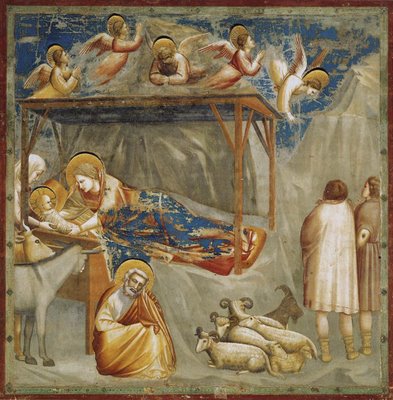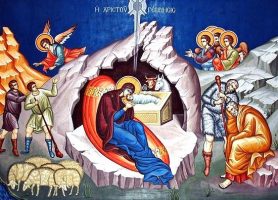This article is adapted from a “reflection” on a class taught by Dr. Al Rossi at St. Vladimir’s Seminary. The class dealt with silence and prayer. The quotes in italics are one-liners by Dr. Rossi.
“For thus said the Lord GOD, the Holy One of Israel, ‘In returning and rest you shall be saved; in quietness and in trust shall be your strength.’”— Isaiah 30:15
One of my professors, Dr. Rossi, related how he would go to New Skete and be silent. The message: There is Someone in silence. This resonates with me somewhat because I visited those holy grounds myself a few Nativity seasons ago, with Fr. Chris. I must say, it impressed me. The monks, their way of life, how everything in the community worked—it all made quite the impression. And silence was definitely a part of the experience. You could sense that these folks had some firsthand experience with the stuff.
I especially remember how they would punctuate Scripture readings and other meditative readings with silence. That was powerful. They actually expected you to ponder what was just read! And, indeed, you could almost taste the silence in the air.
There is Someone in silence. I guess we were made for it, which may help explain why we so often respond in wonder or joy when it occasionally comes into our lives. And yes, God apparently uses silence to call to us, to stir our spirits, and this also may explain why many of us really do feel excited—as though we had received an invitation into something wondrously deep and enchanting— when a Bishop Kallistos or whoever speaks authentically about silence.
But there is someone else in silence.
I am in silence. And I am often unhappy, confused, perplexed, and unsettled. Ill at ease in my own skin and my own thoughts. And so I suspect that if I were to remain at New Skete for, say, two or three weeks or longer, I might not be so rosy about it. After the first few experiences of these still waters, I would grow bored and restless, and all the rest. And this is likely part of the reason why we have to struggle so hard to cultivate silence—passionately, sincerely, and consistently—in our lives! We like to hear about it, but we don’t necessarily want to pay the real price to attain it in earnest.
The essence of faith is knowing that I don’t know. Yes. Say what we will, on a deep level most of us really do freak out about things that are absolutely beyond our comprehension and control, at least if it is something we care about. And God— the meaning of life, our deepest purpose in life, and all the rest—is something that we profoundly yearn to grasp. And yet, we just don’t know. Silence, then, plunges us into these deep and cold waters of our own ignorance about that which we most care to know (Ecclesiastes: “He has set eternity in the hearts of men”). And presumably, this is meant to build our faith, as we learn to accept that we don’t know so many, many things and yet trust God to be God and to know what He is doing.

Nativity of the Lord, Giotto, a fresco in The Scrovegni Chapel, Padua
Silence is a choice. Clearly, we can choose to go for the abiding version of the experience of which we have from time to time caught a glimpse. Our Church traditions tell us so, and so do probably 97% of just about every other serious faith tradition out there, from Zen Buddhism to Islam (it’s what the name “Islam” more or less means—peace through submitting to God’s will; not to mention the Sufis and so on) to Judaism to animism, for crying out loud. And if the Son of God can’t give us peace, who can? Considering the prevalence of “peace” and its permutations throughout the New and Old Testaments, it’s safe to say that it is not God who has failed to offer and provide for our peace. We, then, are called to step up to the plate on this one! It’s really not rocket science, after all.
The thing I personally appreciate about these invitations to peaceful silence and their contrast with my own basic lack of silence and peace is that it forces me to look inside, face up to my inner noise and chaos, and ask myself how serious I am about being a genuinely peaceful person. And the older I get, the more important it appears to me to get with the program and not waste any more time in cultivating this gift. Life is too short, as they say.
And, Lord help us, just in case we had decided that inner peace and quiet are maybe not so important after all, here comes American Christmas—busting down our front door, cluttering our yards, walls, and roofs, and assaulting every one of our senses in a weeks-long, drawnout orgy of self-indulgence, noise, consumerism, goodwill, peace, depression, and various incarnations of chubby and magical “St. Nicholases” who have to do with just about everything—except fasting, prayer, and silence.
Through it all there is much beauty, to be sure. And genuine goodwill. And even glory to God in the highest. But it isn’t always easy to appreciate and hold on to these aspects of “The Holiday Season.” One thing is for certain, though: prayer, as we strive to cultivate silence in our hearts, can help us.
Writing in the second century, St. Ignatius of Antioch said: “Mary’s virginity was hidden from the prince of this world; so was her child-rearing, and so was the death of the Lord. All these three trumpet-tongued secrets were brought to pass in the deep silence of God.” If we want to penetrate and revel in these mysteries—of our Savior’s birth, childhood, and saving death—then we need to begin to enter into this “deep silence of God.” And lest we get caught up in mere externals and begin to bemoan the noise and chaos around us and despair of finding peace and quiet, we should recall that the silence we seek isn’t really dependent on our environment—it is within us. In fact, during the Nativity season, it’s even in the chaos and noise around us, if we only cultivate the ears to hear and the eyes to see.
One place to begin could be to read between the lines of our culture’s typical versions of Christmas to note what we don’t proclaim about the season. The Evangelical author Philip Yancey, in The Jesus I Never Knew, writes insightfully of the silence our culture wraps around the Biblical Christmas stories. He notes that while we focus on the joy and the “good news,” which is there and should be celebrated, we are almost utterly silent about the more disturbing aspects of the story. Thus, we have no Christmas cards commemorating Herod’s slaughter of the Innocents. We prefer not to meditate on the implications of the fact that Mary’s being pregnant at so young an age would be labeled a “crisis pregnancy” in our time. Considering her unmarried status and “angelic visitations,” it is statistically unlikely that our Savior would have even been allowed to be brought to term in the first place. Nor does the fact that the Judea of that time was an occupied territory, politically, economically, and socially under Rome’s heel, seem to get much press. Finally, St. Symeon’s prophecy that a sword would pierce Mary’s soul because of her child, which he told her a mere forty days after Christ’s birth, is just as much a part of the Christmas story as is the story of the shepherds who were keeping watch over their flocks by night. Why, then, does our culture tend to overlook these facets of the Nativity story and only look at the “happy” and “uplifting” ones?
Let’s face it: Jesus Christ was born to die. Our concerns today—long life, “fulfilling one’s potential,” universal health coverage and a guaranteed education for all, an ideal balance of our physical, emotional, intellectual, and spiritual needs, a Christian and yet pluralistic society that is ideally tolerant of all that is not utterly evil in and of itself, etc.—just don’t help us much when we look at the story of Jesus. The King of Glory left heaven for our sakes; He “gave it all up,” so to speak. He was born into a backwater semi-country, grew up in obscurity among “marginalized” people and religious zealots, and died tragically young as some sort of political/religious quasi-revolutionary.
And yet—all of this is good news. At least when seen through the eyes of faith. Again, Jesus Christ was born to die—and to rise again. And He died to effect our own resurrection as well. The tragedy and loss in His life was part of God’s plan to redeem the human race. And the same is true today. We find Christ in the tragedy and loss that is around us and within us; we find His life in death. The Church never lets us forget this.
Recall our Nativity icon. Christ, “sweet baby Jesus,” is swaddled as though wrapped in His shroud for burial. He is, in fact, lying in a coffin-like tomb. This sweet little child is depicted as lying in a cave— precisely as He is to be buried in one. His birth is not something we can perceive or contemplate apart from His death and resurrection. Indeed, His coming to dwell among us—at His birth, during the Liturgy, in the mystery of Baptism, or during His Second Coming—is never something we can contemplate apart from His death and resurrection.
Maybe, then, our culture’s “corruption” of Christmas is not such a bad thing. As they say, the light only shines brighter the darker it gets. No one can “take the Christ out of Christmas.” Christmas, and thus Christ Himself, is in us, in our hearts, in the Church; in “the deep silence of God.” As Dr. Rossi reminds us: there is Someone in silence; the essence of faith is knowing that I don’t know; and silence is a choice. St. Ignatius confirms this, as does Theophan the Recluse, who writes, “The principle thing is to stand with the mind in the heart before God, and to go on standing before Him unceasingly day and night, until the end of life.” As Jesus said, “Peace I leave with you; my peace I give to you…” (John 14:27).
By prayer and fasting, then, now is the time to find and cultivate the silence within us, that we may sing with the whole Church, “Thy Nativity, O Christ our God, has shone to the world the light of wisdom!” (Festal Troparion).
Source: Holy Cross Orthodox Church
















